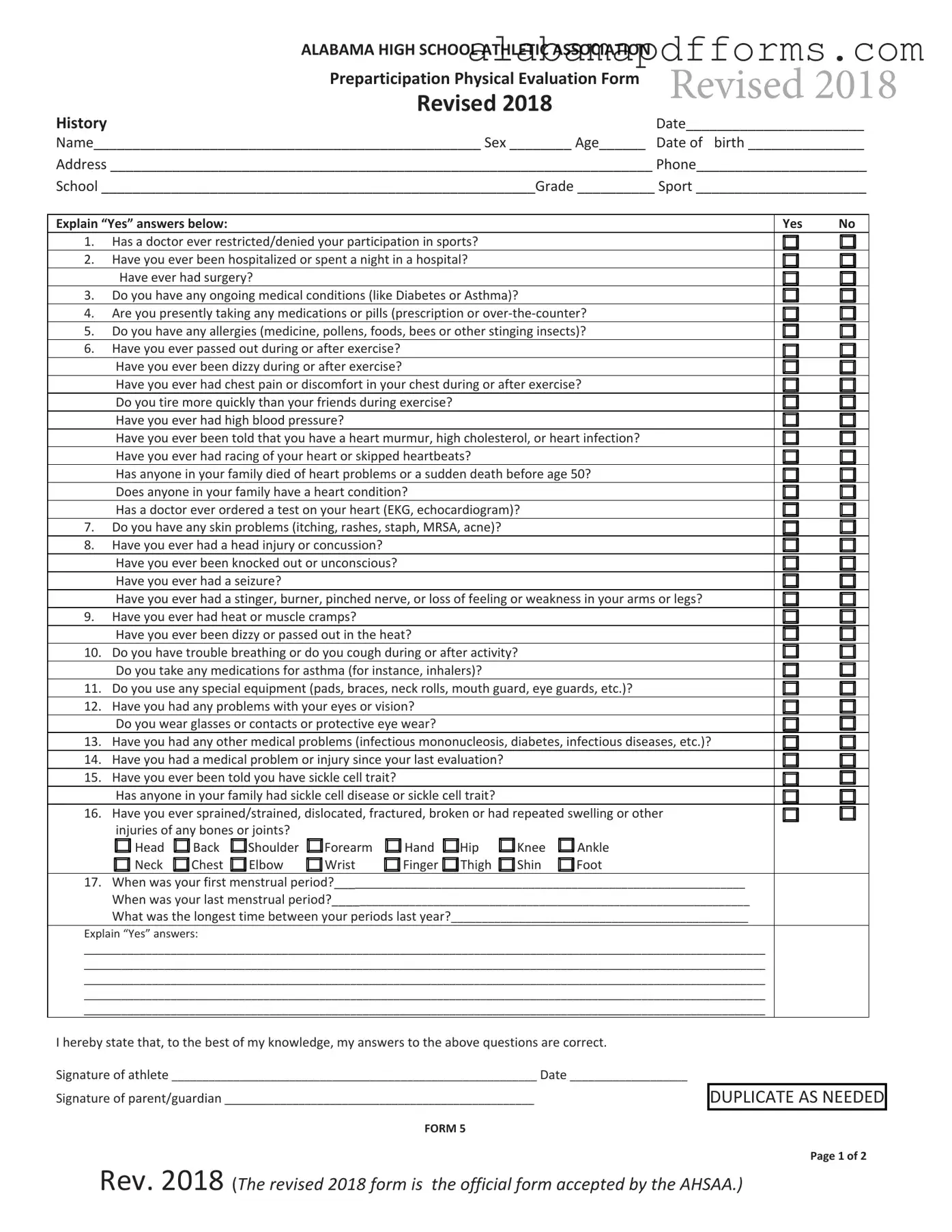Name__________________________________________________ Sex ________ Age______ Date of birth _______________
Address ______________________________________________________________________ Phone______________________
School ________________________________________________________Grade __________ Sport ______________________
Explain “Yes” answers below: |
|
|
|
|
|
Yes |
No |
1. |
Has a doctor ever restricted/denied your participation in sports? |
|
|
|
|
|
2. |
Have you ever been hospitalized or spent a night in a hospital? |
|
|
|
|
|
|
Have ever had surgery? |
|
|
|
|
|
|
|
|
3. |
Do you have any ongoing medical conditions (like Diabetes or Asthma)? |
|
|
|
|
4. |
Are you presently taking any medications or pills (prescription or over‐the‐counter? |
|
5. |
Do you have any allergies (medicine, pollens, foods, bees or other stinging insects)? |
|
6. |
Have you ever passed out during or after exercise? |
|
|
|
|
|
|
|
|
|
|
|
|
|
|
|
Have you ever been dizzy during or after exercise? |
|
|
|
|
|
|
|
|
Have you ever had chest pain or discomfort in your chest during or after exercise? |
|
|
Do you tire more quickly than your friends during exercise? |
|
|
|
|
|
|
|
Have you ever had high blood pressure? |
|
|
|
|
|
|
|
|
Have you ever been told that you have a heart murmur, high cholesterol, or heart infection? |
|
|
Have you ever had racing of your heart or skipped heartbeats? |
|
|
|
|
|
|
Has anyone in your family died of heart problems or a sudden death before age 50? |
|
|
Does anyone in your family have a heart condition? |
|
|
|
|
|
|
|
Has a doctor ever ordered a test on your heart (EKG, echocardiogram)? |
|
|
|
|
7. |
Do you have any skin problems (itching, rashes, staph, MRSA, acne)? |
|
|
|
|
|
8. |
Have you ever had a head injury or concussion? |
|
|
|
|
|
|
|
|
Have you ever been knocked out or unconscious? |
|
|
|
|
|
|
|
|
Have you ever had a seizure? |
|
|
|
|
|
|
|
|
|
Have you ever had a stinger, burner, pinched nerve, or loss of feeling or weakness in your arms or legs? |
|
9. |
Have you ever had heat or muscle cramps? |
|
|
|
|
|
|
|
|
Have you ever been dizzy or passed out in the heat? |
|
|
|
|
|
|
10. Do you have trouble breathing or do you cough during or after activity? |
|
|
|
|
|
Do you take any medications for asthma (for instance, inhalers)? |
|
|
|
|
|
11. Do you use any special equipment (pads, braces, neck rolls, mouth guard, eye guards, etc.)? |
|
12. Have you had any problems with your eyes or vision? |
|
|
|
|
|
|
|
Do you wear glasses or contacts or protective eye wear? |
|
|
|
|
|
|
13. Have you had any other medical problems (infectious mononucleosis, diabetes, infectious diseases, etc.)? |
|
14. Have you had a medical problem or injury since your last evaluation? |
|
|
|
|
|
15. Have you ever been told you have sickle cell trait? |
|
|
|
|
|
|
|
|
Has anyone in your family had sickle cell disease or sickle cell trait? |
|
|
|
|
|
16. Have you ever sprained/strained, dislocated, fractured, broken or had repeated swelling or other |
|
|
injuries of any bones or joints? |
|
|
|
|
|
|
|
|
|
Head |
Back |
Shoulder |
Forearm |
Hand |
Hip |
Knee |
Ankle |
|
|
Neck |
Chest |
Elbow |
Wrist |
Finger |
Thigh |
Shin |
Foot |
|
______________________________________________________________________________________________________________
______________________________________________________________________________________________________________
______________________________________________________________________________________________________________
______________________________________________________________________________________________________________
______________________________________________________________________________________________________________


